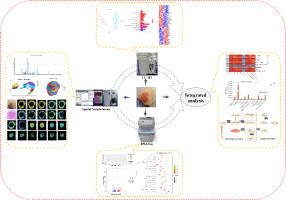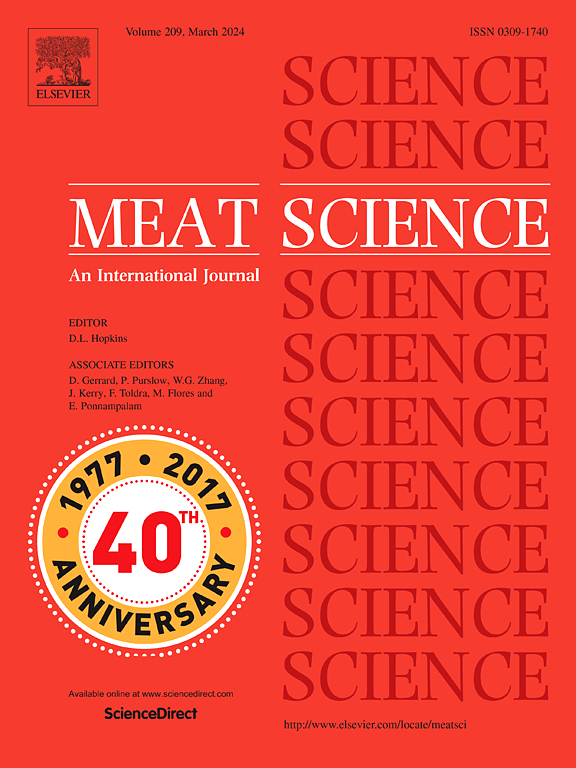Spatial metabolomics, LC-MS and RNA-Seq reveal the effect of red and white muscle on rabbit meat flavor
IF 7.1
1区 农林科学
Q1 Agricultural and Biological Sciences
引用次数: 0
Abstract
Meat quality is a key factor influencing consumer purchasing decisions. Muscle composition consists of various types of myofibers (type I and type IIa, IIb, IIx myofibers), and the relative composition of fiber types has a significant impact on the overall biochemical properties and flavor of fresh meat. However, the relationship between biochemical changes in myofibers and their impact on meat quality remains underexplored. In this study, we compared the differences in meat quality by examining different muscles in rabbits, each containing different muscle fiber types. We focused on the adductor (ADD) and semitendinosus (ST) as our research subjects and investigated skeletal muscle metabolism at the individual myofibers level using Spatial metabolomics. Additionally, we utilized LC-MS and RNA-Seq to explore the molecular mechanisms underlying the metabolic differences between red and white muscle fibers. Our findings demonstrated that variations in myofiber composition significantly influenced meat color, pH, water content, and drip loss. Spatial metabolomics analysis identified 22 unique red and white muscle fingerprint metabolites, while LC-MS analysis revealed 123 differential metabolites, and these differential metabolites were mainly enriched in the pathways of ABC transporters, Biosynthesis of amino acids, glutathione metabolism, and arginine biosynthesis. To further elucidate the molecular mechanism of differential metabolism in ADD and ST, we identified 2248 differentially expressed genes (DEGs) by RNA-Seq and then combined DEGs with DMs for joint analysis. We found that red muscle exhibited higher levels of metabolites such as L-glutamic acid, glutathione, ascorbate, ornithine, oxidized glutathione, gamma-L-glutamyl-L-cysteine, cysteinylglycine, fumaric acid, gamma-aminobutyric acid. Additionally, related metabolic genes such as MGST1, ODC1, MGST3 and PRDX6 were highly expressed in ST muscle. These metabolites and genes were enriched in the glutathione and nicotinamide pathways, and had significant effects on meat color and drip loss. Moreover, red muscle contained more flavor compounds and nutrients, including adenosine monophosphate (AMP), ornithine, citrulline, taurine, acetyl phosphate, L-glutamic acid metabolites, as well as taurine and hypotaurine metabolites. Our results demonstrate that fresh meat with a higher proportion of red muscle fibers exhibited superior meat quality, enhanced flavor, and higher nutrient content. Furthermore, red muscle contains more antioxidant metabolites that can effectively prevent meat oxidation during the production process.

空间代谢组学、LC-MS 和 RNA-Seq 揭示红肌和白肌对兔肉风味的影响
摘要 肉质是影响消费者购买决定的关键因素。肌肉成分由各种类型的肌纤维(I 型和 IIa、IIb、IIx 型肌纤维)组成,纤维类型的相对组成对鲜肉的整体生化特性和风味有重要影响。然而,肌纤维的生化变化与其对肉质的影响之间的关系仍未得到充分探索。在这项研究中,我们通过检测兔子的不同肌肉(每块肌肉都含有不同的肌纤维类型)来比较肉质的差异。我们以内收肌(ADD)和半腱肌(ST)为研究对象,利用空间代谢组学研究了单个肌纤维水平的骨骼肌代谢。此外,我们还利用 LC-MS 和 RNA-Seq 探索了红白肌纤维代谢差异的分子机制。我们的研究结果表明,肌纤维成分的变化对肉色、pH 值、含水量和滴水损失有显著影响。空间代谢组学分析确定了 22 种独特的红白肌指纹代谢物,而 LC-MS 分析则揭示了 123 种差异代谢物,这些差异代谢物主要富集在 ABC 转运体、氨基酸的生物合成、谷胱甘肽代谢和精氨酸生物合成等途径中。为进一步阐明ADD和ST代谢差异的分子机制,我们通过RNA-Seq鉴定了2248个差异表达基因(DEGs),然后将DEGs与DMs结合起来进行联合分析。我们发现,红肌的代谢物水平较高,如 L-谷氨酸、谷胱甘肽、抗坏血酸、鸟氨酸、氧化谷胱甘肽、γ-L-谷氨酰-L-半胱氨酸、半胱氨酸、富马酸、γ-氨基丁酸等。此外,MGST1、ODC1、MGST3 和 PRDX6 等相关代谢基因在 ST 肌肉中高表达。这些代谢物和基因富集在谷胱甘肽和烟酰胺途径中,对肉色和滴水损失有显著影响。此外,红肌肉含有更多的风味化合物和营养物质,包括单磷酸腺苷(AMP)、鸟氨酸、瓜氨酸、牛磺酸、乙酰磷酸、L-谷氨酸代谢物以及牛磺酸和低牛磺酸代谢物。我们的研究结果表明,红肌肉纤维比例较高的鲜肉肉质更好、风味更佳、营养成分含量更高。此外,红肌肉含有更多的抗氧化代谢物,可有效防止肉类在生产过程中氧化。
本文章由计算机程序翻译,如有差异,请以英文原文为准。
求助全文
约1分钟内获得全文
求助全文
来源期刊

Meat Science
工程技术-食品科技
CiteScore
12.60
自引率
9.90%
发文量
282
审稿时长
60 days
期刊介绍:
The aim of Meat Science is to serve as a suitable platform for the dissemination of interdisciplinary and international knowledge on all factors influencing the properties of meat. While the journal primarily focuses on the flesh of mammals, contributions related to poultry will be considered if they enhance the overall understanding of the relationship between muscle nature and meat quality post mortem. Additionally, papers on large birds (e.g., emus, ostriches) as well as wild-captured mammals and crocodiles will be welcomed.
 求助内容:
求助内容: 应助结果提醒方式:
应助结果提醒方式:


